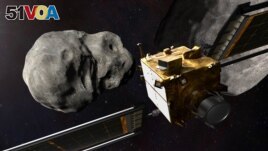01 January 2023
The American space agency NASA announced several major mission successes in 2022. Today, we look back at some of the agency's biggest developments in the past year.
DART mission crashes spacecraft into asteroid
NASA announced in October that its experiment to crash a spacecraft into an asteroid had successfully changed the path of the orbiting object. Officials said it was the first time in history that a human action had changed the motion of a space object.

This artist's illustration depicts NASA's DART spacecraft, which will be launched to crash into an asteroid to see how the crash affects the space object's path. (Image Credit: NASA/Johns Hopkins APL)
NASA's DART spacecraft crashed in September into an asteroid called Dimorphos about 11 million kilometers from Earth. Dimorphos is a small "moonlet" that orbits a larger asteroid named Didymos.
The goal of the crash was to see how it might redirect the asteroid's path and speed. The crash reduced the object's orbital period by 32 minutes. NASA scientists had predicted a reduction of 10 minutes. So, they were pleased with the test results.
NASA described the crash as the world's first planetary defense test. The targeted asteroid did not present an actual threat to Earth.
Webb Space Telescope releases first images
In July, NASA began releasing the first images captured by its James Webb Space Telescope. Officials described the Webb as "the largest and most powerful" science telescope ever built.
The orbiting observatory is a large infrared telescope that builds on the work of earlier telescopes, such as the Hubble and Spitzer. But the Webb is designed to gather more data and explore parts of space never observed before.
NASA praised the work of the Webb development team and said the telescope had begun "a new era in astronomy."
In November, scientists said the Webb had also identified bright, early galaxies for the first time. One of the galaxies might have formed only 350 million years after the Big Bang, the event that explains the beginning of the universe.
Artemis I test mission around the moon
In November, NASA launched its Space Launch System (SLS) rocket, which U.S. officials have called the most powerful rocket ever built.
The SLS rocket carried the Orion spacecraft, or capsule, into space. The goal was to carry out an uncrewed test mission to fly around the moon. The mission was part of the space agency's Artemis program, which aims to land Americans on the moon by the mid-2020s.
During a news conference earlier this month, NASA officials said they were pleased with how Orion and its systems had performed during the mission. No major problems were reported.
NASA said Orion had traveled more than 2.2 million kilometers during the test mission. The capsule parachuted into the Pacific Ocean off the coast of southern California on December 11 and was safely recovered.
The goal of Artemis I was to prepare for Artemis II, which will include astronauts. That is to be followed by Artemis III, which will aim to land astronauts on the moon's surface. If that goal is reached, it would be the first moon landing by astronauts since NASA's Apollo 17 mission in 1972.
Curiosity reaches new target area on Mars
After a summer trip, NASA announced in October its Curiosity explorer vehicle had reached its next exploration target on Mars.
The explorer, or rover, reached an area known as Mount Sharp. The area sits within the planet's Gale Crater, which Curiosity has been exploring since landing on Mars in 2012. Mount Sharp contains a mix of rocky material and many large hills.
Researchers have found past evidence that Mount Sharp contained many water systems billions of years ago. But scientists believe at some point, the Martian climate grew more extreme and caused the water to dry up.
Any minerals still existing in the area might provide additional evidence of severe changes to the Martian climate. Shortly after arriving in the area, Curiosity's instruments discovered many different kinds and sizes. Among the discoveries were several different salt compounds that suggest the presence of water in the past.
I'm Bryan Lynn.
Bryan Lynn wrote this story for VOA Learning English.
____________________________________________________________
Words in This Story
asteroid – n. a rocky object that goes around the sun like a planet
era – n. a period in history that is special for a particular reason